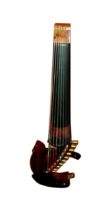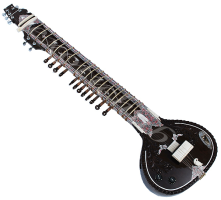9 STRING ELECTRIC VIOLIN
9 string electric violin- The violin was made for Steve Kindler by California luthier John Jordan. This is the first instrument of it’s kind in the world. The highest string is tuned to A, a 4th higher than the E string on the acoustic violin. The rest of the strings are tuned in fifths from the highest to the lowest Đ A, E, A, D, G, C, F, Bb, Eb.

In the context of the orchestral string family, the strings E, A, D and G are standard violin strings, the C string is the same as the C on the viola, the F and Bb strings are one whole-step lower than the bottom 2 strings of the cello, while the Eb is one half-step lower than the bottom string of the double bass.
OUD
The Oud is a stringed instrument considered to be the ancestor of the lute, also known as an Arabic lute or Persian lute. It originally comes from Persia and the Middle East, being first brought to Europe during the time of the Moorish Caliphate in the Iberian Peninsula. In Arab countries, oud is as popular as guitar or piano in European countries. It is an instrument without frets. In modern times the instrument usually has 5 double strings and an additional bass string, 11 in total.
For playing on the oud the musician uses a flexible plectrum (Arabian reeshe, risha, or mizrap) with a length of about 10-15 cm. Traditionally it was made from an eagle feather, but now much more readily available plastic plectrums are used.
BAGLAMA (SAZ)
Sometimes referred to as the saz (from the Persian), sometimes referred to as the „cura”, this refers to a family of plucked string instruments of the type of long-necked lutes, used in Ottoman classical music, Turkish folk music, Iranian music, Azeri music, Kurdish music, Assyrian music, Armenian music, and in parts of Syria, Iraq and the Balkan countries. Instruments resembling today’s baglama have been found in archaeological excavations of Sumerian and Hittite mounds in Anatolia dating before Common Era, and in ancient Greek works. According to The New Grove Dictionary of Music and Musicians, „the terms ‚baglama’ and ‚saz’ are used somewhat interchangeably in Turkey.” Like the Western lute and the Middle-Eastern oud, it has a deep round back, but a much longer neck. It can be played with a plectrum or with a fingerpicking style known as şelpe. In the music of Greece the name baglamas (Greek) is given to a treble bouzouki, or related instrument. The Turkish settlement of Anatolia from the late eleventh century onward saw the introduction of a two-string Turkmen dutar, which was played in certain regions of Turkey until recent times.
SITAR
The Sitar (English:Sitar; Punjabi: Sitar, Urdu: Sitar Đ is a plucked stringed instrument used in Hindustani classical music. The instrument is believed to have been derived from the veena, an ancient Indian instrument, which was modified by a Mughal court musician to conform with the tastes of his Mughal patrons and named after a Persian instrument called the setar (meaning three strings). The sitar flourished in the 16th and 17th centuries and arrived at its present form in 18th-century India. It derives its distinctive timbre and resonance from sympathetic strings, bridge design, a long hollow neck and a gourd-shaped resonance chamber. In appearance, the sitar is similar to the tanpura, except that it has frets.
Fusion sitar
Used widely throughout the Indian subcontinent, the sitar became popularly known in the wider world through the works of Ravi Shankar, beginning in the late 1950s and early 1960s. In the 1960s, a short-lived trend arose for the use of the sitar in Western popular music, with the instrument appearing on tracks by bands such as The Beatles, The Doors, The Rolling Stones and others.
SHRUTI BOX
Sruti Box- A shruti box (sruti box or surpeti) is an instrument that traditionally works on a system of bellows. It is similar to a harmonium and is used to provide a drone in a practice session or concert of Indian classical music. It is used as an accompaniment to other instruments and notably the flute. The sruti box is also used in classical singing. In classical singing the sruti box is used to help tune the voice.
 The use of the sruti box has widened with the cross-cultural influences of world music and new-age music to provide a drone for many other instruments as well as vocalists. Nowadays, electronic sruti boxes are commonly used, which are called sruti petti in Tamil and Telugu and sur peti in Hindi. Recent versions also allow for changes to be made in the tempo, and the notes such as Madhyamam, Nishadam to be played in place of the usual three notes ( i.e., Lower shadjam, panchamam, and theupper shadjam ).
The use of the sruti box has widened with the cross-cultural influences of world music and new-age music to provide a drone for many other instruments as well as vocalists. Nowadays, electronic sruti boxes are commonly used, which are called sruti petti in Tamil and Telugu and sur peti in Hindi. Recent versions also allow for changes to be made in the tempo, and the notes such as Madhyamam, Nishadam to be played in place of the usual three notes ( i.e., Lower shadjam, panchamam, and theupper shadjam ).

